Inferences on the 2021 Ongoing Volcanic Unrest at Vulcano Island (Italy) through a Comprehensive Multidisciplinary Surveillance Network
Abstract
1. Introduction
2. Materials and Methods
2.1. Current-State INGV Monitoring System at Vulcano
2.2. Composition and Temperature of Fumarolic Gases
2.3. The High-Temperature Fumaroles (HTF) Monitoring Network
2.4. The Steam-Heated Soil (SHS) Monitoring Station
2.5. SO2 Flux from Fumaroles
2.6. Continuous and Discrete Measurements of Soil CO2 Flux
2.7. Continuous and Discrete Measurements on Thermal Waters
2.8. Seismic Data and Analyses
2.9. GNSS
2.10. Tiltmeters
2.11. Gravimetry
3. Multidisciplinary Data Record from June 2020 to April 2022
3.1. Fumarole Gas Chemistry and SO2 Emissions
3.2. Heat Flux and Thermal Anomalies
3.3. Soil CO2 Degassing
3.4. Thermal Groundwaters
3.5. Seismic Activity
3.5.1. Seismo-Volcanic Activity
3.5.2. Volcano-Tectonic Activity
3.6. Ground Deformation
3.6.1. GNSS
3.6.2. Tiltmeters
3.6.3. Continuous Gravity Measurements
4. Discussion
4.1. Phase A: 1 February-8 September 2021
4.2. Phase B: From 8 September to 31 October 2021
4.3. Phase C: From 1 November 2021 Onward
4.4. The Processes behind the Unrest
5. Conclusions
Supplementary Materials
Author Contributions
Funding
Data Availability Statement
Acknowledgments
Conflicts of Interest
References
- Allard, P.; Aiuppa, A.; Beauducel, F.; Gaudin, D.; Di Napoli, R.; Calabrese, S.; Parello, F.; Crispi, O.; Hammouya, G.; Tamburello, G. Steam and Gas Emission Rate from La Soufriere Volcano, Guadeloupe (Lesser Antilles): Implications for the Magmatic Supply during Degassing Unrest. Chem. Geol. 2014, 384, 76–93. [Google Scholar] [CrossRef]
- Tamburello, G.; Moune, S.; Allard, P.; Venugopal, S.; Robert, V.; Rosas-Carbajal, M.; Deroussi, S.; Kitou, G.-T.; Didier, T.; Komorowski, J.; et al. Spatio-Temporal Relationships between Fumarolic Activity, Hydrothermal Fluid Circulation and Geophysical Signals at an Arc Volcano in Degassing Unrest: La Soufrière of Guadeloupe (French West Indies). Geosciences 2019, 9, 480. [Google Scholar] [CrossRef]
- Melián, G.V.; Hernández, P.A.; Pérez, N.M.; Asensio-Ramos, M.; Padrón, E.; Alonso, M.; Padilla, G.D.; Barrancos, J.; Sortino, F.; Sumino, H.; et al. Insights from Fumarole Gas Geochemistry on the Recent Volcanic Unrest of Pico Do Fogo, Cape Verde. Front. Earth Sci. 2021, 9, 631190. [Google Scholar] [CrossRef]
- Clocchiatti, R.; Del Moro, A.; Gioncada, A.; Joron, J.L.; Mosbah, M.; Pinarelli, L.; Sbrana, A. Assessment of a Shallow Magmatic System: The 1888–90 Eruption, Vulcano Island, Italy. Bull. Volcanol. 1994, 56, 466–486. [Google Scholar] [CrossRef]
- Mercalli, G. I Vulcani Attivi della Terra: Morfologia, Dinamismo, Prodotti, Distribuzione Geografica, Cause; Lampi di Stampa: Milano, Italy, 2011; ISBN 978-88-488-1135-4. [Google Scholar]
- Paonita, A.; Federico, C.; Bonfanti, P.; Capasso, G.; Inguaggiato, S.; Italiano, F.; Madonia, P.; Pecoraino, G.; Sortino, F. The Episodic and Abrupt Geochemical Changes at La Fossa Fumaroles (Vulcano Island, Italy) and Related Constraints on the Dynamics, Structure, and Compositions of the Magmatic System. Geochim. Cosmochim. Acta 2013, 120, 158–178. [Google Scholar] [CrossRef]
- Mazzuoli, R.; Tortorici, L.; Ventura, G. Oblique Rifting in Salina, Lipari and Vulcano Islands (Aeolian Islands, Southern Italy). Terra Nova 1995, 7, 444–452. [Google Scholar] [CrossRef]
- De Astis, G.; Lucchi, F.; Dellino, P.; La Volpe, L.; Tranne, C.; Frezzotti, M.; Peccerillo, A. Geology, Volcanic History and Petrology of Vulcano (Central Aeolian Archipelago). Geol. Soc. Lond. Mem. 2013, 37, 281–349. [Google Scholar] [CrossRef]
- Barreca, G.; Bruno, V.; Cultrera, F.; Mattia, M.; Monaco, C.; Scarfì, L. New Insights in the Geodynamics of the Lipari–Vulcano Area (Aeolian Archipelago, Southern Italy) from Geological, Geodetic and Seismological Data. J. Geodyn. 2014, 82, 150–167. [Google Scholar] [CrossRef]
- Ruch, J.; Vezzoli, L.; De Rosa, R.; Di Lorenzo, R.; Acocella, V. Magmatic Control along a Strike-Slip Volcanic Arc: The Central Aeolian Arc (Italy): MAGMATISM AND STRIKE-SLIP FAULTING. Tectonics 2016, 35, 407–424. [Google Scholar] [CrossRef]
- Selva, J.; Bonadonna, C.; Branca, S.; De Astis, G.; Gambino, S.; Paonita, A.; Pistolesi, M.; Ricci, T.; Sulpizio, R.; Tibaldi, A.; et al. Multiple Hazards and Paths to Eruptions: A Review of the Volcanic System of Vulcano (Aeolian Islands, Italy). Earth-Sci. Rev. 2020, 207, 103186. [Google Scholar] [CrossRef]
- Ventura, G.; Vilardo, G.; Milano, G.; Pino, N.A. Relationships among Crustal Structure, Volcanism and Strike–Slip Tectonics in the Lipari–Vulcano Volcanic Complex (Aeolian Islands, Southern Tyrrhenian Sea, Italy). Phys. Earth Planet. Inter. 1999, 116, 31–52. [Google Scholar] [CrossRef]
- Gambino, S.; Milluzzo, V.; Scaltrito, A.; Scarfì, L. Relocation and Focal Mechanisms of Earthquakes in the South-Central Sector of the Aeolian Archipelago: New Structural and Volcanological Insights. Tectonophysics 2012, 524–525, 108–115. [Google Scholar] [CrossRef]
- Badalamenti, B.; Gurrieri, S.; Hauser, S.; Valenza, M. Ground CO2 Output in the Island of Vulcano during the Period 1984–1988: Gas Hazard and Volcanic Activity Surveillance Implications. Bull. Miner. Rend. Soc. Ital. Miner. Pet. 1988, 43, 893–899. [Google Scholar]
- Baubron, J.; Allard, P.; Toutain, J. Diffuse Volcanic Emissions of Carbon Dioxide from Vulcano Island, Italy. Nature 1990, 344, 51–53. [Google Scholar] [CrossRef] [PubMed]
- Badalamenti, B.; Gurrieri, S.; Hauser, S.; Parello, F.; Valenza, M. Change in CO2 Output at Vulcano Island during Summer 1988. Acta Vulcanol. 1991, 1, 219–221. [Google Scholar]
- Barberi, F.; Neri, G.; Valenza, M.; Villari, L. 1987–1990 Unrest at Vulcano. Acta Vulcanol. 1991, 1, 95–106. [Google Scholar]
- Chiodini, G.; Cioni, R.; Falsaperla, S.; Montalto, A.; Guidi, M.; Marini, L. Geochemical and Seismological Investigations at Vulcano (Aeolian Islands) during 1978–1989. J. Geophys. Res. 1992, 97, 11025. [Google Scholar] [CrossRef]
- Chiodini, G.; Cioni, R.; Marini, L.; Panichi, C. Origin of the Fumarolic Fluids of Vulcano Island, Italy and Implications for Volcanic Surveillance. Bull. Volcanol. 1995, 57, 99–110. [Google Scholar] [CrossRef]
- Chiodini, G.; Frondini, F.; Raco, B. Diffuse Emission of CO2 from the Fossa Crater, Vulcano Island (Italy). Bull. Volcanol. 1996, 58, 41–50. [Google Scholar] [CrossRef]
- Capasso, G.; Favara, R.; Inguaggiato, S. Chemical Features and Isotopic Composition of Gaseous Manifestations on Vulcano Island, Aeolian Islands, Italy: An Interpretative Model of Fluid Circulation. Geochim. Cosmochim. Acta 1997, 61, 3425–3440. [Google Scholar] [CrossRef]
- Chiodini, G.; Cioni, R.; Guidi, M.; Raco, B.; Marini, L. Soil CO2 Flux Measurements in Volcanic and Geothermal Areas. Appl. Geochem. 1998, 13, 543–552. [Google Scholar] [CrossRef]
- Diliberto, I.; Gurrieri, S.; Valenza, M. Relationships between Diffuse CO2 Emissions and Volcanic Activity on the Island of Vulcano (Aeolian Islands, Italy) during the Period 1984–1994. Bull. Volcanol. 2002, 64, 219–228. [Google Scholar] [CrossRef]
- Aubert, M.; Diliberto, S.; Finizola, A.; Chébli, Y. Double Origin of Hydrothermal Convective Flux Variations in the Fossa of Vulcano (Italy). Bull. Volcanol. 2008, 70, 743–751. [Google Scholar] [CrossRef]
- Carapezza, M.L.; Barberi, F.; Ranaldi, M.; Ricci, T.; Tarchini, L.; Barrancos, J.; Fischer, C.; Perez, N.; Weber, K.; Di Piazza, A.; et al. Diffuse CO2 Soil Degassing and CO2 and H2S Concentrations in Air and Related Hazards at Vulcano Island (Aeolian Arc, Italy). J. Volcanol. Geotherm. Res. 2011, 207, 130–144. [Google Scholar] [CrossRef]
- Italiano, F.; Pecoraino, G.; Nuccio, P. Steam Output from Fumaroles of an Active Volcano: Tectonic and Magmatic-hydrothermal Controls on the Degassing System at Vulcano (Aeolian Arc). J. Geophys. Res. Solid Earth 1998, 103, 29829–29842. [Google Scholar] [CrossRef]
- Diliberto, I.S. Cyclic Behavior in the Fumaroles Output Detected by Direct Measurement of Temperature of the Ground. Eng. Proc. 2021, 5, 47. [Google Scholar]
- Capasso, G.; Favara, R.; Francofonte, S.; Inguaggiato, S. Chemical and Isotopic Variations in Fumarolic Discharge and Thermal Waters at Vulcano Island (Aeolian Islands, Italy) during 1996: Evidence of Resumed Volcanic Activity. J. Volcanol. Geotherm. Res. 1999, 88, 167–175. [Google Scholar] [CrossRef]
- Alparone, S.; Cannata, A.; Gambino, S.; Gresta, S.; Milluzzo, V.; Montalto, P. Time-Space Variation of Volcano-Seismic Events at La Fossa (Vulcano, Aeolian Islands, Italy): New Insights into Seismic Sources in a Hydrothermal System. Bull. Volcanol. 2010, 72, 803–816. [Google Scholar] [CrossRef]
- Granieri, D.; Carapezza, M.L.; Chiodini, G.; Avino, R.; Caliro, S.; Ranaldi, M.; Ricci, T.; Tarchini, L. Correlated Increase in CO2 Fumarolic Content and Diffuse Emission from La Fossa Crater (Vulcano, Italy): Evidence of Volcanic Unrest or Increasing Gas Release from a Stationary Deep Magma Body? Geophys. Res. Lett. 2006, 33, L13316. [Google Scholar] [CrossRef]
- Nuccio, P.; Paonita, A.; Sortino, F. Geochemical Modeling of Mixing between Magmatic and Hydrothermal Gases: The Case of Vulcano Island, Italy. Earth Planet. Sci. Lett. 1999, 167, 321–333. [Google Scholar] [CrossRef]
- Carapezza, M.; Dongarrà, G.; Hauser, S.; Longinelli, A. Preliminary Isotopic Investigation on Thermal Waters from Vulcano Island, Italy. Mineral. Petrogr. Acta 1983, 27, 221–232. [Google Scholar]
- Capasso, G.; Dongarrà, G.; Favara, R.; Hauser, S.; Valenza, M. Isotope Composition of Rain Water, Well Water and Fumarole Steam on the Island of Vulcano, and Their Implications for Volcanic Surveillance. J. Volcanol. Geotherm. Res. 1992, 49, 147–155. [Google Scholar] [CrossRef]
- Bolognesi, L.; D’Amore, F. Isotopic Variation of the Hydrothermal System on Vulcano Island, Italy. Geochim. Cosmochim. Acta 1993, 57, 2069–2082. [Google Scholar] [CrossRef]
- Aiuppa, A.; Dongarrà, G.; Capasso, G.; Allard, P. Trace Elements in the Thermal Groundwaters of Vulcano Island (Sicily). J. Volcanol. Geotherm. Res. 2000, 98, 189–207. [Google Scholar] [CrossRef]
- Federico, C.; Capasso, G.; Paonita, A.; Favara, R. Effects of Steam-Heating Processes on a Stratified Volcanic Aquifer: Stable Isotopes and Dissolved Gases in Thermal Waters of Vulcano Island (Aeolian Archipelago). J. Volcanol. Geotherm. Res. 2010, 192, 178–190. [Google Scholar] [CrossRef]
- Capasso, G.; Federico, C.; Madonia, P.; Paonita, A. Response of the Shallow Aquifer of the Volcano-Hydrothermal System during the Recent Crises at Vulcano Island (Aeolian Archipelago, Italy). J. Volcanol. Geotherm. Res. 2014, 273, 70–80. [Google Scholar] [CrossRef]
- Falsaperla, S.; Frazzetta, G.; Neri, G.; Nunnari, G.; Velardita, R.; Villari, L. Volcano Monitoring in the Aeolian Islands (Southern Tyrrhenian Sea): The Lipari-Vulcano Eruptive Complex. In Volcanic Hazards; Springer: Berlin/Heidelberg, Germany, 1989; pp. 339–356. [Google Scholar]
- Bonforte, A.; Guglielmino, F. Transpressive Strain on the Lipari–Vulcano Volcanic Complex and Dynamics of the “La Fossa” Cone (Aeolian Islands, Sicily) Revealed by GPS Surveys on a Dense Network. Tectonophysics 2008, 457, 64–70. [Google Scholar] [CrossRef]
- Mattia, M.; Palano, M.; Bruno, V.; Cannavò, F.; Bonaccorso, A.; Gresta, S. Tectonic Features of the Lipari-Vulcano Complex (Aeolian Archipelago, Italy) from 10 Years (1996–2006) of GPS Data. Terra Nova 2008, 20, 370–377. [Google Scholar] [CrossRef]
- Gambino, S.; Guglielmino, F. Ground Deformation Induced by Geothermal Processes: A Model for La Fossa Crater (Vulcano Island, Italy). J. Geophys. Res. 2008, 113, B07402. [Google Scholar] [CrossRef]
- Bonaccorso, A.; Bonforte, A.; Gambino, S. Thermal Expansion-Contraction and Slope Instability of a Fumarole Field Inferred from Geodetic Measurements at Vulcano. Bull. Volcanol. 2010, 72, 791–801. [Google Scholar] [CrossRef]
- Harris, A.; Alparone, S.; Bonforte, A.; Dehn, J.; Gambino, S.; Lodato, L.; Spampinato, L. Vent Temperature Trends at the Vulcano Fossa Fumarole Field: The Role of Permeability. Bull. Volcanol. 2012, 74, 1293–1311. [Google Scholar] [CrossRef]
- Latter, J.H. Near Surface Seismicity of Vulcano, Aeolian Islands, Sicily. Bull. Volcanol. 1971, 35, 117–126. [Google Scholar] [CrossRef]
- Milluzzo, V.; Cannata, A.; Alparone, S.; Gambino, S.; Hellweg, M.; Montalto, P.; Cammarata, L.; Diliberto, I.S.; Gresta, S.; Liotta, M.; et al. Tornillos at Vulcano: Clues to the Dynamics of the Hydrothermal System. J. Volcanol. Geotherm. Res. 2010, 198, 377–393. [Google Scholar] [CrossRef]
- Cannata, A.; Diliberto, I.S.; Alparone, S.; Gambino, S.; Gresta, S.; Liotta, M.; Madonia, P.; Milluzzo, V.; Aliotta, M.; Montalto, P. Multiparametric Approach in Investigating Volcano-Hydrothermal Systems: The Case Study of Vulcano (Aeolian Islands, Italy). Pure Appl. Geophys. 2012, 169, 167–182. [Google Scholar] [CrossRef]
- Alparone, S.; Bonforte, A.; Gambino, S.; Guglielmino, F.; Obrizzo, F.; Velardita, R. Dynamics of Vulcano Island (Tyrrhenian Sea, Italy) Investigated by Long-Term (40 Years) Geophysical Data. Earth-Sci. Rev. 2019, 190, 521–535. [Google Scholar] [CrossRef]
- Mattia, M.; Palano, M.; Bruno, V.; Cannavò, F. Crustal Motion along the Calabro-Peloritano Arc as Imaged by Twelve Years of Measurements on a Dense GPS Network. Tectonophysics 2009, 476, 528–537. [Google Scholar] [CrossRef]
- Berrino, G.; Corrado, G.; Luongo, G. Gravity Changes and Dynamics of the Aeolian Islands. Rendiconti Della Soc. Ital. Mineral. E Petrogr. 1988, 43, 935–946. [Google Scholar]
- Berrino, G. Combined Gravimetry in the Observation of Volcanic Processes in Southern Italy. J. Geodyn. 2000, 30, 371–388. [Google Scholar] [CrossRef]
- Di Maio, R.; Berrino, G. Joint Analysis of Electric and Gravimetric Data for Volcano Monitoring. Application to Data Acquired at Vulcano Island (Southern Italy) from 1993 to 1996. J. Volcanol. Geotherm. Res. 2016, 327, 459–468. [Google Scholar] [CrossRef]
- Camarda, M.; De Gregorio, S.; Capasso, G.; Di Martino, R.M.; Gurrieri, S.; Prano, V. The Monitoring of Natural Soil CO2 Emissions: Issues and Perspectives. Earth-Sci. Rev. 2019, 198, 102928. [Google Scholar] [CrossRef]
- Inguaggiato, S.; Vita, F.; Diliberto, I.S.; Mazot, A.; Calderone, L.; Mastrolia, A.; Corrao, M. The Extensive Parameters as a Tool to Monitoring the Volcanic Activity: The Case Study of Vulcano Island (Italy). Remote Sens. 2022, 14, 1283. [Google Scholar] [CrossRef]
- Diliberto, I.S. Long-Term Variations of Fumarole Temperatures on Vulcano Island (Italy). Ann. Geophys. 2011, 54, 175–185. [Google Scholar]
- Diliberto, I.S. Time Series Analysis of High Temperature Fumaroles Monitored on the Island of Vulcano (Aeolian Archipelago, Italy). J. Volcanol. Geotherm. Res. 2013, 264, 150–163. [Google Scholar] [CrossRef]
- Inguaggiato, S.; Diliberto, I.S.; Federico, C.; Paonita, A.; Vita, F. Review of the Evolution of Geochemical Monitoring, Networks and Methodologies Applied to the Volcanoes of the Aeolian Arc (Italy). Earth-Sci. Rev. 2018, 176, 241–276. [Google Scholar] [CrossRef]
- Capasso, G.; Inguaggiato, S.; Nuccio, P.; Pecoraino, G.; Sortino, F. Compositional Evolution of the Fumarolic Gases Emitted at the Crater of Vulcano during 1987–1993. In Proceedings of the Independent Publishers Group World Organization of Volcano Observatories Meeting, Guadalupe, CA, USA, 13–17 December 1993; pp. 13–17. [Google Scholar]
- Taylor, J. Introduction to Error Analysis, the Study of Uncertainties in Physical Measurements; University Science Books: New York NY, USA, 1997; ISBN 0-935702-42-3. [Google Scholar]
- Salerno, G.G.; Burton, M.R.; Oppenheimer, C.; Caltabiano, T.; Randazzo, D.; Bruno, N.; Longo, V. Three-Years of SO2 Flux Measurements of Mt. Etna Using an Automated UV Scanner Array: Comparison with Conventional Traverses and Uncertainties in Flux Retrieval. J. Volcanol. Geotherm. Res. 2009, 183, 76–83. [Google Scholar] [CrossRef]
- Salerno, G.; Burton, M.; Oppenheimer, C.; Caltabiano, T.; Tsanev, V.; Bruno, N. Novel Retrieval of Volcanic SO2 Abundance from Ultraviolet Spectra. J. Volcanol. Geotherm. Res. 2009, 181, 141–153. [Google Scholar] [CrossRef]
- Camarda, M.; Gurrieri, S.; Valenza, M. CO2 Flux Measurements in Volcanic Areas Using the Dynamic Concentration Method: Influence of Soil Permeability: CO2 Flux Measurements Using the Dynamic Method. J. Geophys. Res. Solid Earth 2006, 111, B05202. [Google Scholar] [CrossRef]
- Sicardi, L. Il recente ciclo dell’ attività fumarolica dell’ isola di Vulcano. Bull. Volcanol. 1940, 7, 85–139. [Google Scholar] [CrossRef]
- Patanè, D.; Tusa, G.; Yang, W.; Astuti, A.; Colino, A.; Costanza, A.; D’Anna, G.; Di Prima, S.; Fertitta, G.; Mangiagli, S.; et al. The Urban Seismic Observatory of Catania (Italy): A Real-Time Seismic Monitoring at Urban Scale. Remote Sens. 2022, 14, 2583. [Google Scholar] [CrossRef]
- Barberi, G.; Di Grazia, G.; Ferrari, F.; Giampiccolo, E.; Maiolino, V.; Mostaccio, A.; Musumeci, C.; Scaltrito, A.; Sciotto, M.; Tusa, G.; et al. Mt. Etna Revised Seismic Catalog from 2020 (EtnaRSC2020) 2020, 500 MB; Istituto Nazionale di Geofisica e Vulcanologia: Rome, Italy, 2020. [Google Scholar]
- Lahr, J.C. HYPOELLIPSE/Version 2.0; a Computer Program for Determining Local Earthquake Hydrocentral Parameters, Magnitude, and First Motion Pattern; US Geological Survey: Reston, VA, USA, 1989. [Google Scholar]
- Jeffreys, H.; Bullen, K.E. Seismological Tables: Office of the British Association; Burlington House: London, UK, 1958. [Google Scholar]
- Reasenberg, P.; Oppenheimer, D. FPFIT, FPPLOT and FPPAGE: FORTRAN Computer Programs for Calculating and Displaying Earthquake Fault-Plane Solutions. U.S. Geol. Surv. Open-File Rep. 1985, 85–739. [Google Scholar] [CrossRef]
- Cannata, A.; Di Grazia, G.; Aliotta, M.; Cassisi, C.; Montalto, P.; Patanè, D. Monitoring Seismo-Volcanic and Infrasonic Signals at Volcanoes: Mt. Etna Case Study. Pure Appl. Geophys. 2013, 170, 1751–1771. [Google Scholar] [CrossRef]
- Trnkoczy, A. Understanding and Parameter Setting of STA/LTA Trigger Algorithm. In New Manual of Seismological Observatory Practice (NMSOP); Deutsches GeoForschungsZentrum GFZ: Potsdam, Germany, 2012; 20p. [Google Scholar] [CrossRef]
- Kawakatsu, H.; Kaneshima, S.; Matsubayashi, H.; Ohminato, T.; Sudo, Y.; Tsutsui, T.; Uhira, K.; Yamasato, H.; Ito, H.; Legrand, D. Aso94: Aso Seismic Observation with Broadband Instruments. J. Volcanol. Geotherm. Res. 2000, 101, 129–154. [Google Scholar] [CrossRef]
- Almendros, J.; Chouet, B. Performance of the Radial Semblance Method for the Location of Very Long Period Volcanic Signals. Bull. Seismol. Soc. Am. 2003, 93, 1890–1903. [Google Scholar] [CrossRef]
- Hering, T.A.; King, R.W.; Floyd, M.A.; McClusky, S.C. GLOBK: Global Kalman Filter VLBI and GPS Analysis Program; Massachusetts Institute of Technology: Cambridge, MA, USA, 2015. [Google Scholar]
- Hering, T.A.; King, R.W.; Floyd, M.A.; McClusky, S.C. GAMIT Reference Manual. GPS Analysis at MIT; Massachusetts Institute of Technology: Cambridge, MA, USA, 2018. [Google Scholar]
- Altamimi, Z.; Rebischung, P.; Métivier, L.; Collilieux, X. ITRF2014: A New Release of the International Terrestrial Reference Frame Modeling Nonlinear Station Motions: ITRF2014. J. Geophys. Res. Solid Earth 2016, 121, 6109–6131. [Google Scholar] [CrossRef]
- Gambino, S.; Campisi, O.; Falzone, G.; Ferro, A.; Guglielmino, F.; Laudani, G.; Saraceno, B. Tilt Measurements at Vulcano Island. Ann. Geophys. 2007, 50, 233–247. [Google Scholar] [CrossRef]
- Gambino, S.; Falzone, G.; Ferro, A.; Laudani, G. Volcanic Processes Detected by Tiltmeters: A Review of Experience on Sicilian Volcanoes. J. Volcanol. Geotherm. Res. 2014, 271, 43–54. [Google Scholar] [CrossRef]
- Tamburello, G.; Kantzas, E.; McGonigle, A.; Aiuppa, A.; Giudice, G. UV Camera Measurements of Fumarole Field Degassing (La Fossa Crater, Vulcano Island). J. Volcanol. Geotherm. Res. 2011, 199, 47–52. [Google Scholar] [CrossRef]
- Vita, F.; Inguaggiato, S.; Bobrowski, N.; Calderone, L.; Galle, B.; Parello, F. Continuous SO2 Flux Measurements for Vulcano Island, Italy. Ann. Geophys. 2012, 55, 301–308. [Google Scholar]
- Granieri, D.; Vita, F.; Inguaggiato, S. Volcanogenic SO2, a Natural Pollutant: Measurements, Modeling and Hazard Assessment at Vulcano Island (Aeolian Archipelago, Italy). Environ. Pollut. 2017, 231, 219–228. [Google Scholar] [CrossRef]
- Arellano, S.; Galle, B.; Apaza, F.; Avard, G.; Barrington, C.; Bobrowski, N.; Bucarey, C.; Burbano, V.; Burton, M.; Chacón, Z. Synoptic Analysis of a Decade of Daily Measurements of SO 2 Emission in the Troposphere from Volcanoes of the Global Ground-Based Network for Observation of Volcanic and Atmospheric Change. Earth Syst. Sci. Data 2021, 13, 1167–1188. [Google Scholar] [CrossRef]
- Di Martino, R.M.R.; Capasso, G.; Camarda, M. Spatial Domain Analysis of Carbon Dioxide from Soils on Vulcano Island: Implications for CO2 Output Evaluation. Chem. Geol. 2016, 444, 59–70. [Google Scholar] [CrossRef]
- Di Martino, R.M.R.; Gurrieri, S.; Camarda, M.; Capasso, G.; Prano, V. Hazardous Changes in Soil CO2 Emissions at Vulcano, Italy, in 2021. J. Geophys. Res. Solid Earth 2022, 127, e2022JB024516. [Google Scholar] [CrossRef]
- German Aerospace Center. TanDEM-X—Digital Elevation Model (DEM)—Global, 90 m; German Aerospace Center: Cologne, Germany, 2018. [Google Scholar]
- Paonita, A.; Favara, R.; Nuccio, P.; Sortino, F. Genesis of Fumarolic Emissions as Inferred by Isotope Mass Balances: CO2 and Water at Vulcano Island, Italy. Geochim. Cosmochim. Acta 2002, 66, 759–772. [Google Scholar] [CrossRef]
- Mandarano, M.; Paonita, A.; Martelli, M.; Viccaro, M.; Nicotra, E.; Millar, I.L. Revealing Magma Degassing below Closed-Conduit Active Volcanoes: Geochemical Features of Volcanic Rocks versus Fumarolic Fluids at Vulcano (Aeolian Islands, Italy). Lithos 2016, 248, 272–287. [Google Scholar] [CrossRef]
- Chouet, B. Volcano Seismology. Pure Appl. Geophys. 2003, 160, 739–788. [Google Scholar] [CrossRef]
- Carapezza, M.; Nuccio, P.; Valenza, M. Genesis and Evolution of the Fumaroles of Vulcano (Aeolian Islands, Italy): A Geochemical Model. Bull. Volcanol. 1981, 44, 547–563. [Google Scholar] [CrossRef]
- Inguaggiato, S.; Vita, F.; Diliberto, I.S.; Inguaggiato, C.; Mazot, A.; Cangemi, M.; Corrao, M. The Volcanic Activity Changes Occurred in the 2021–2022 at Vulcano Island (Italy), Inferred by the Abrupt Variations of Soil CO2 Output. Sci. Rep. 2022, 12, 21166. [Google Scholar] [CrossRef]
- Capasso, G.; D’Alessandro, W.; Favara, R.; Inguaggiato, S.; Parello, F. Interaction between the Deep Fluids and the Shallow Groundwaters on Vulcano Island (Italy). J. Volcanol. Geotherm. Res. 2001, 108, 187–198. [Google Scholar] [CrossRef]
- Di Martino, R.M.R.; Capasso, G.; Camarda, M.; De Gregorio, S.; Prano, V. Deep CO2 Release Revealed by Stable Isotope and Diffuse Degassing Surveys at Vulcano (Aeolian Islands) in 2015–2018. J. Volcanol. Geotherm. Res. 2020, 401, 106972. [Google Scholar] [CrossRef]
- Falsaperla, S. Tectonic Seismicity with M >= 1.8 at the Island of Vulcano, Italy, from July to September 1988 (TSV_JS1988); Istituto Nazionale di Geofisica e Vulcanologia: Rome, Italy, 2021. [Google Scholar]
- Todesco, M.; Berrino, G. Modeling Hydrothermal Fluid Circulation and Gravity Signals at the Phlegraean Fields Caldera. Earth Planet. Sci. Lett. 2005, 240, 328–338. [Google Scholar] [CrossRef]
- Gottsmann, J.; Rymer, H.; Wooller, L. On the Interpretation of Gravity Variations in the Presence of Active Hydrothermal Systems: Insights from the Nisyros Caldera, Greece. Geophys. Res. Lett. 2005, 32, L23310. [Google Scholar] [CrossRef]
- Müller, D.; Bredemeyer, S.; Zorn, E.; De Paolo, E.; Walter, T.R. Surveying Fumarole Sites and Hydrothermal Alteration by Unoccupied Aircraft Systems (UAS) at the La Fossa Cone, Vulcano Island (Italy). J. Volcanol. Geotherm. Res. 2021, 413, 107208. [Google Scholar] [CrossRef]
- Müller, D.; Pisciotta, A.; Walter, T.R. Structural and Geothermal Changes Mapped by Drone-Based Photogrammetry and Thermal Infrared during the 2021 Volcanic Crisis of Vulcano Island, Sicily. In Proceedings of the 24th EGU General Assembly, Vienna, Austria, 23–27 May 2022. [Google Scholar]
- Barde-Cabusson, S.; Finizola, A.; Revil, A.; Ricci, T.; Piscitelli, S.; Rizzo, E.; Angeletti, B.; Balasco, M.; Bennati, L.; Byrdina, S. New Geological Insights and Structural Control on Fluid Circulation in La Fossa Cone (Vulcano, Aeolian Islands, Italy). J. Volcanol. Geotherm. Res. 2009, 185, 231–245. [Google Scholar] [CrossRef]
- Di Liberto, V.; Nuccio, P.; Paonita, A. Genesis of Chlorine and Sulphur in Fumarolic Emissions at Vulcano Island (Italy): Assessment of PH and Redox Conditions in the Hydrothermal System. J. Volcanol. Geotherm. Res. 2002, 116, 137–150. [Google Scholar] [CrossRef]
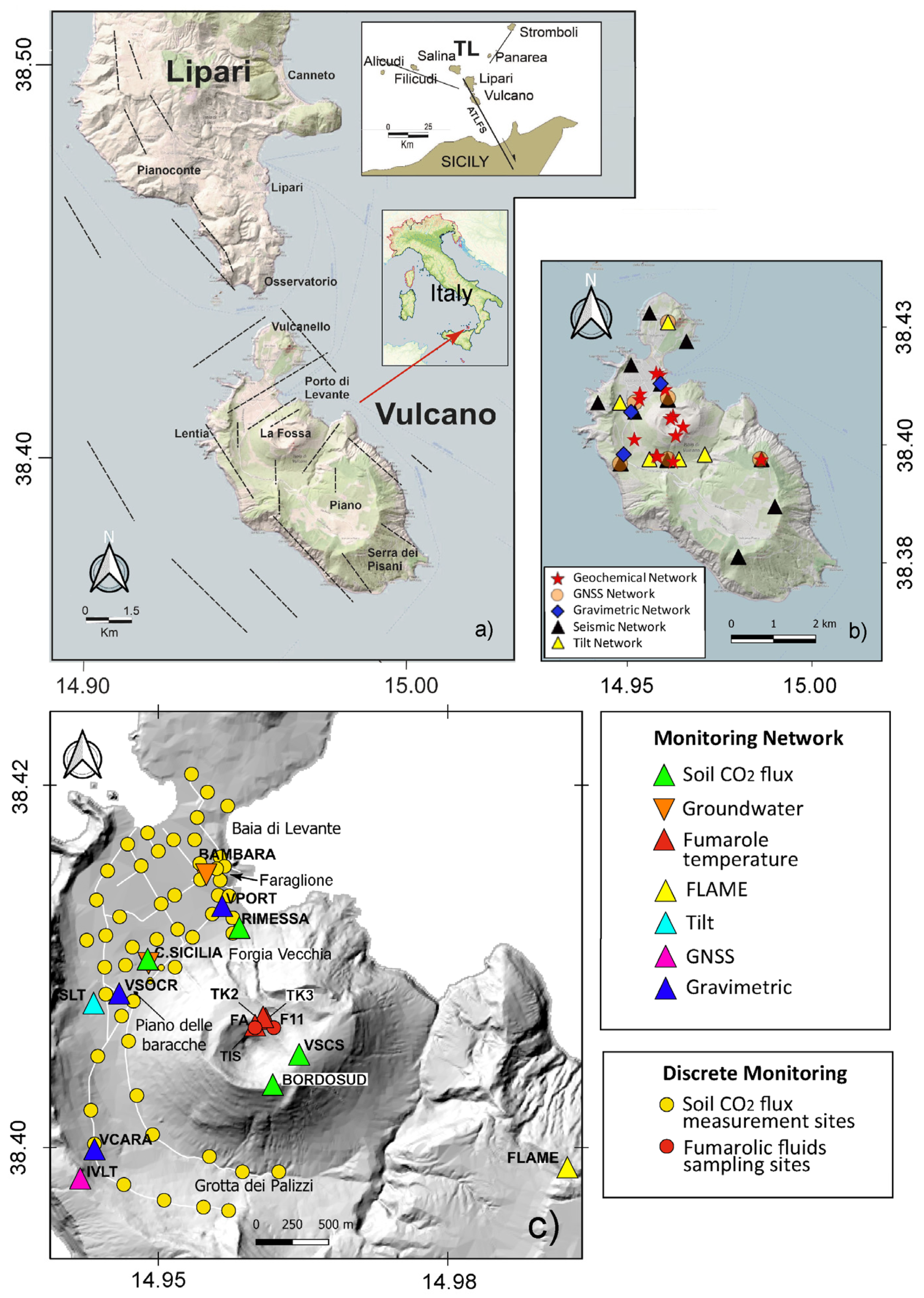
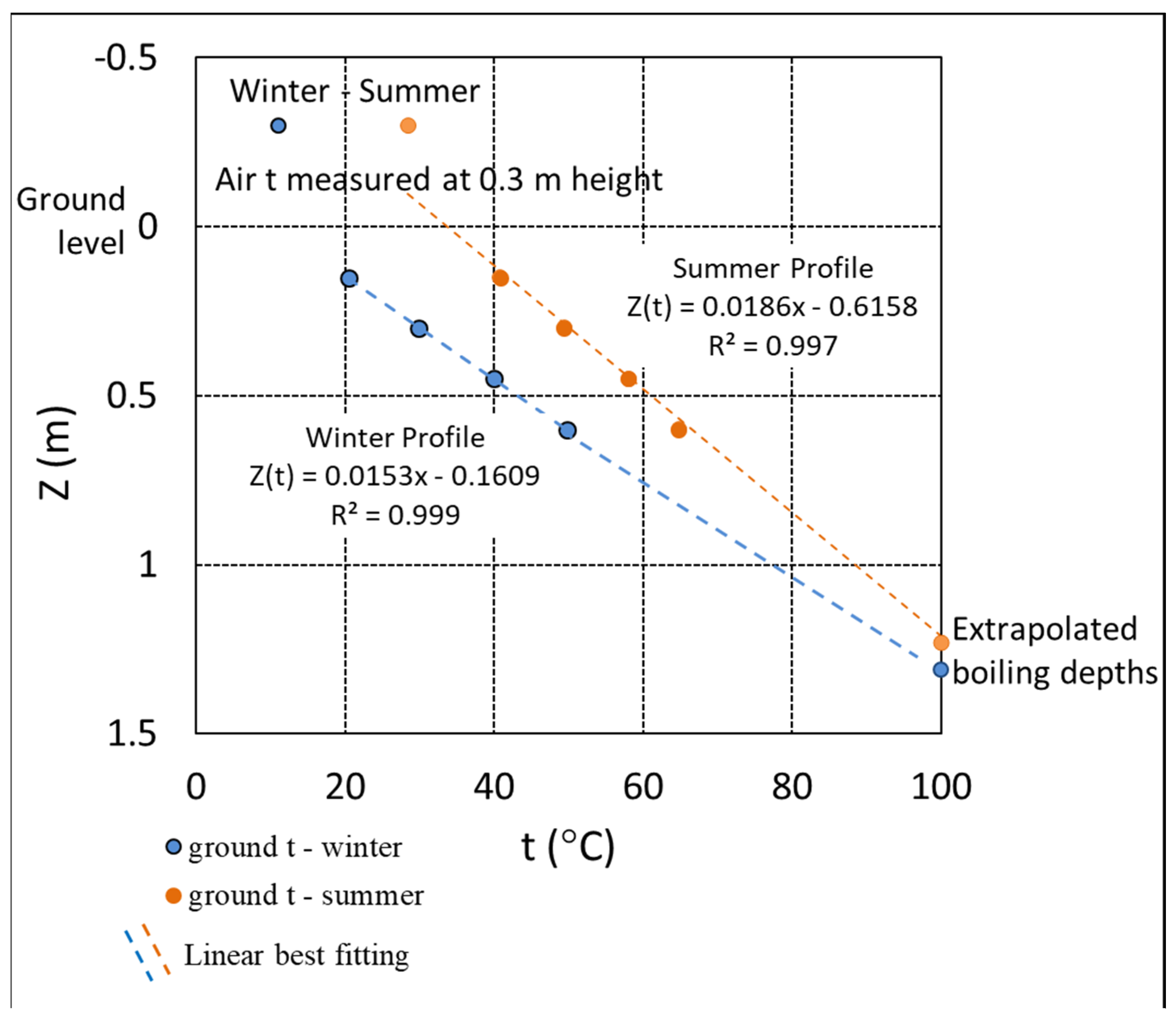

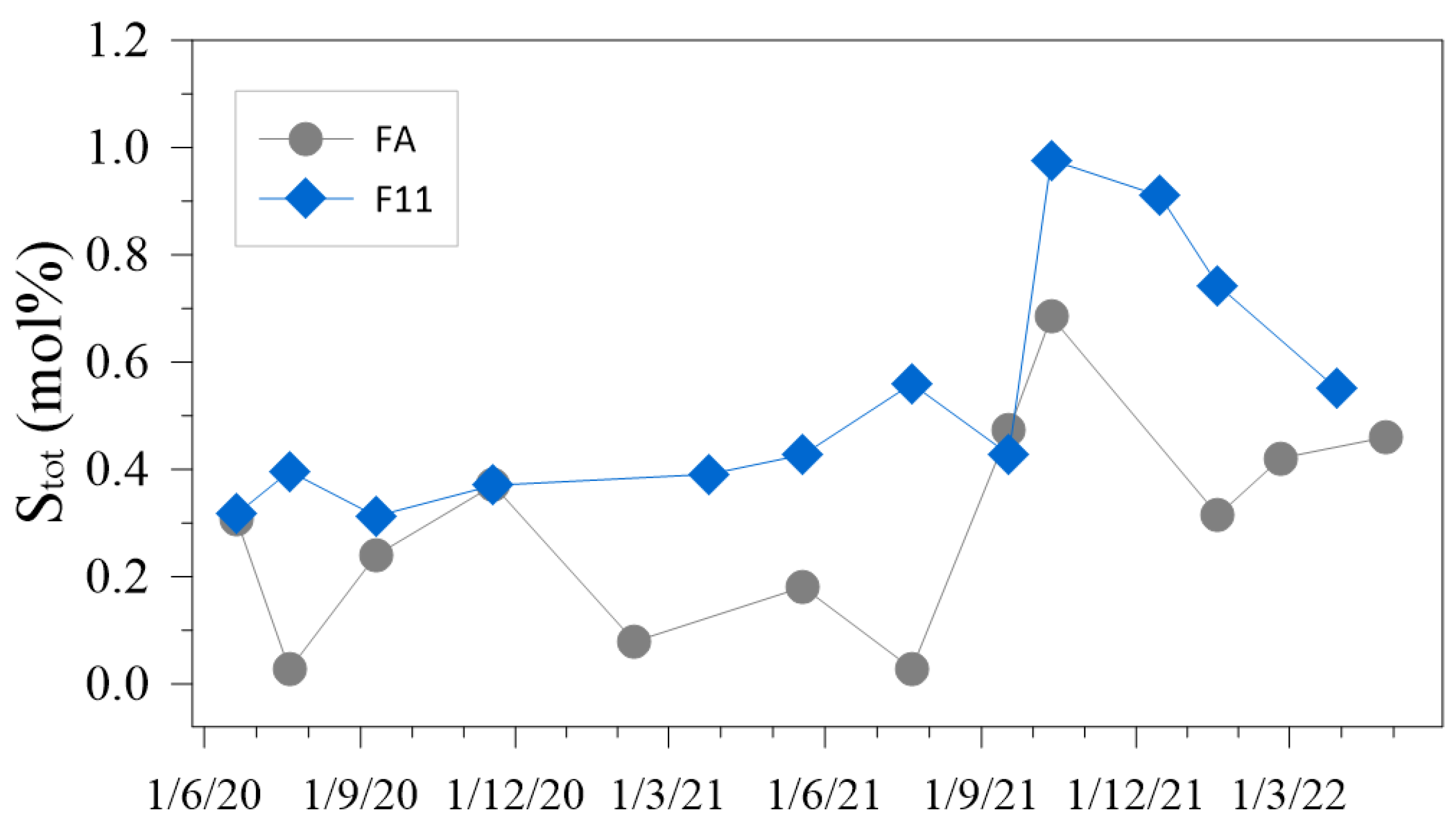
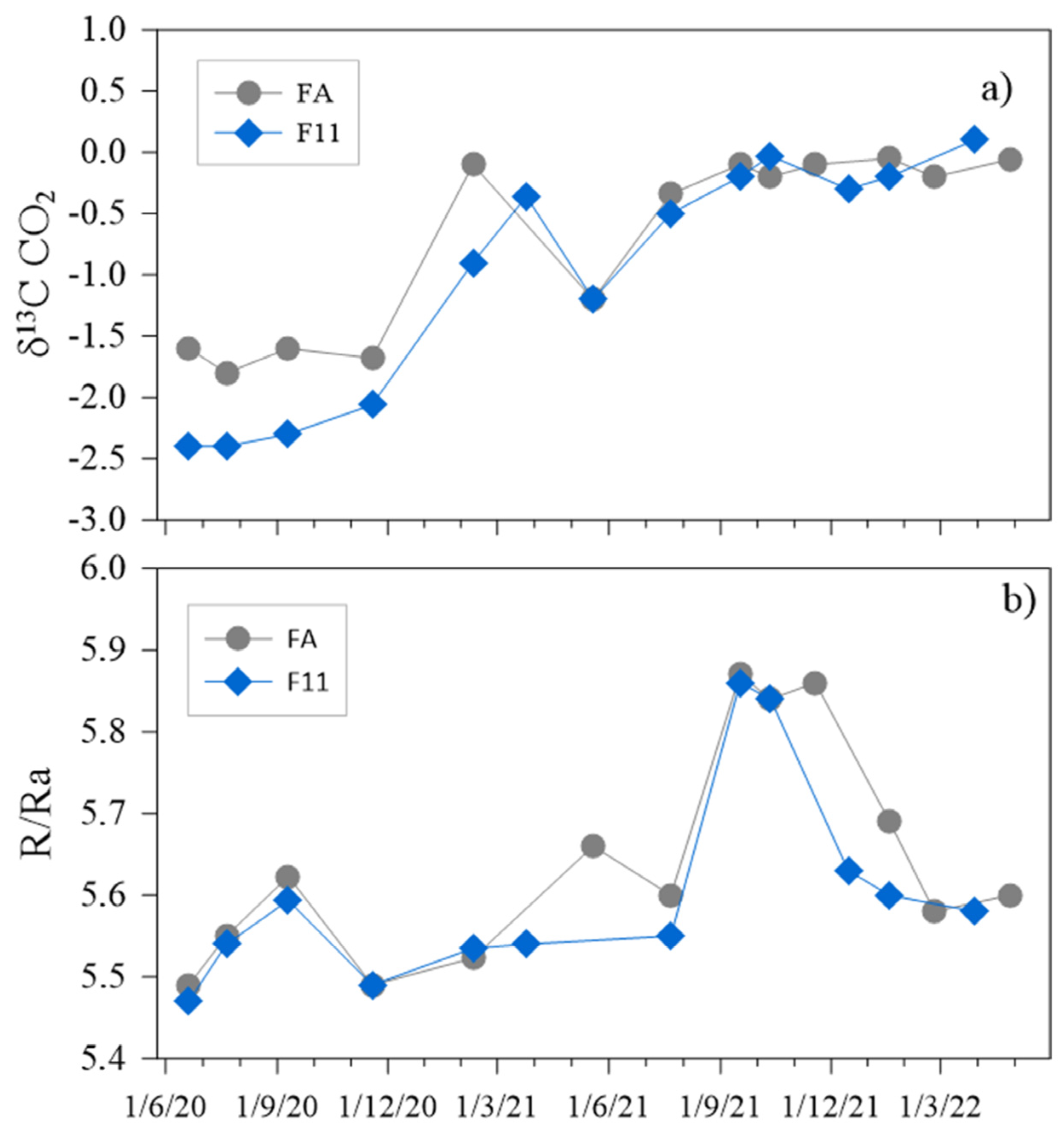
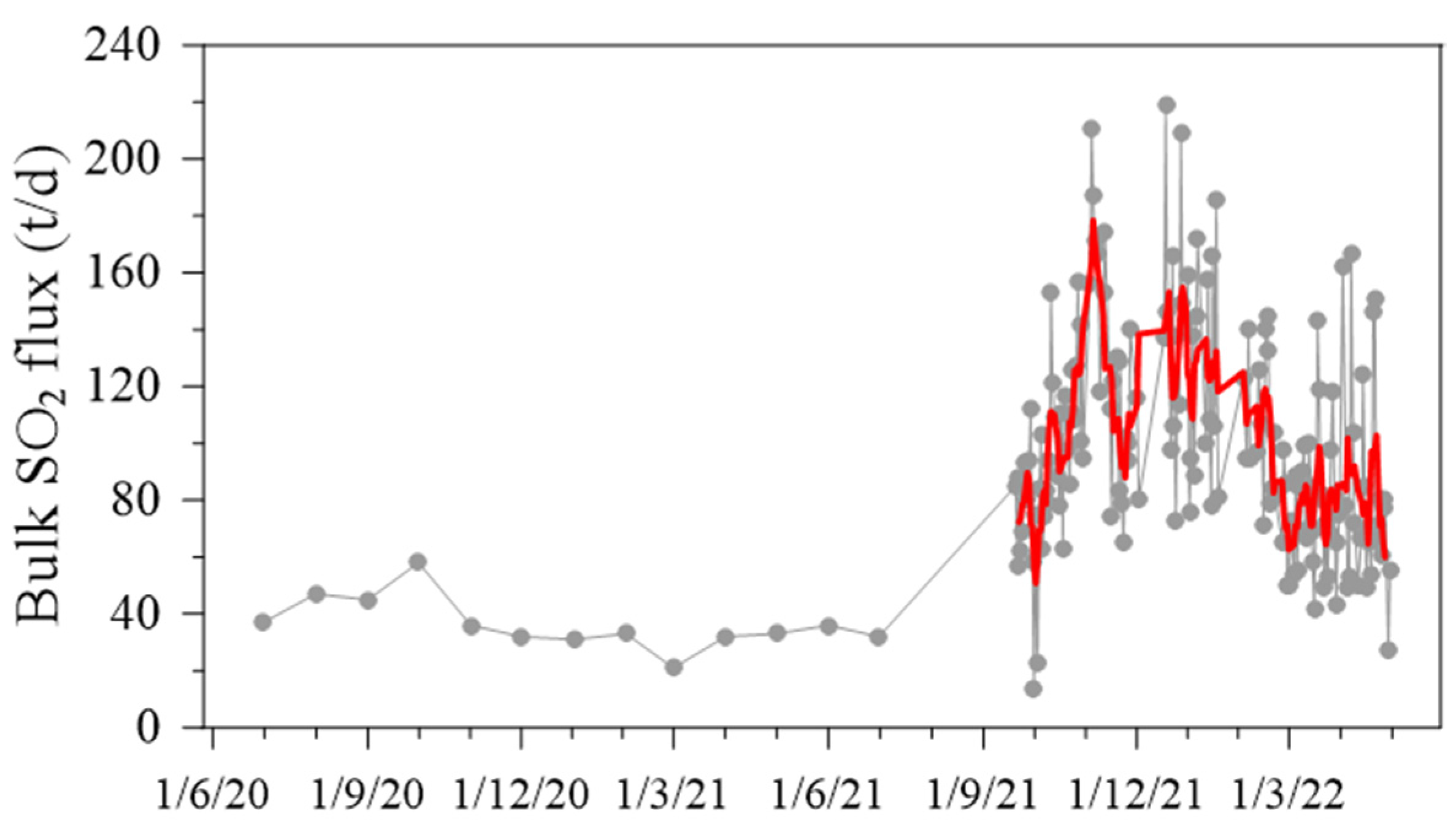

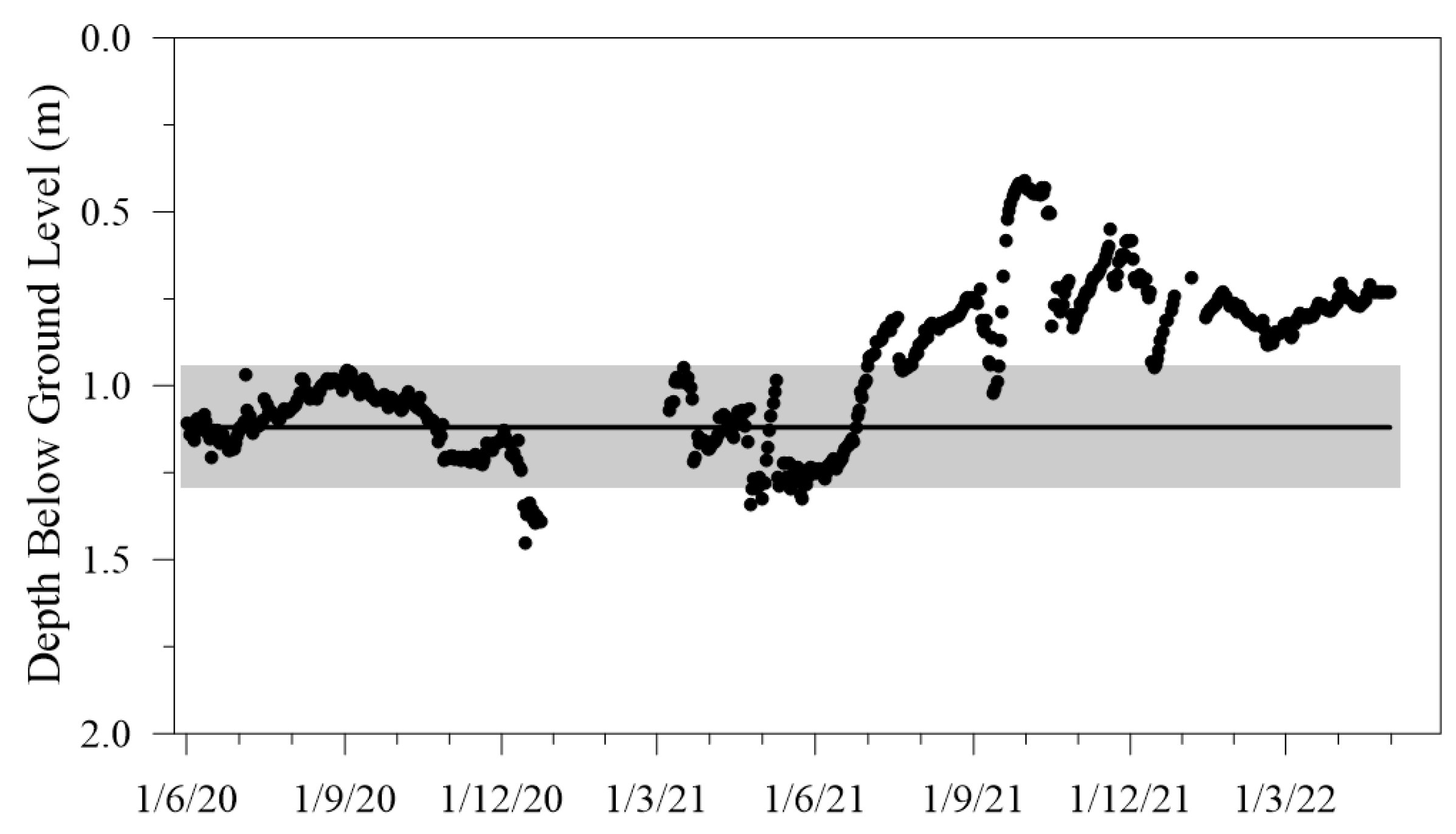
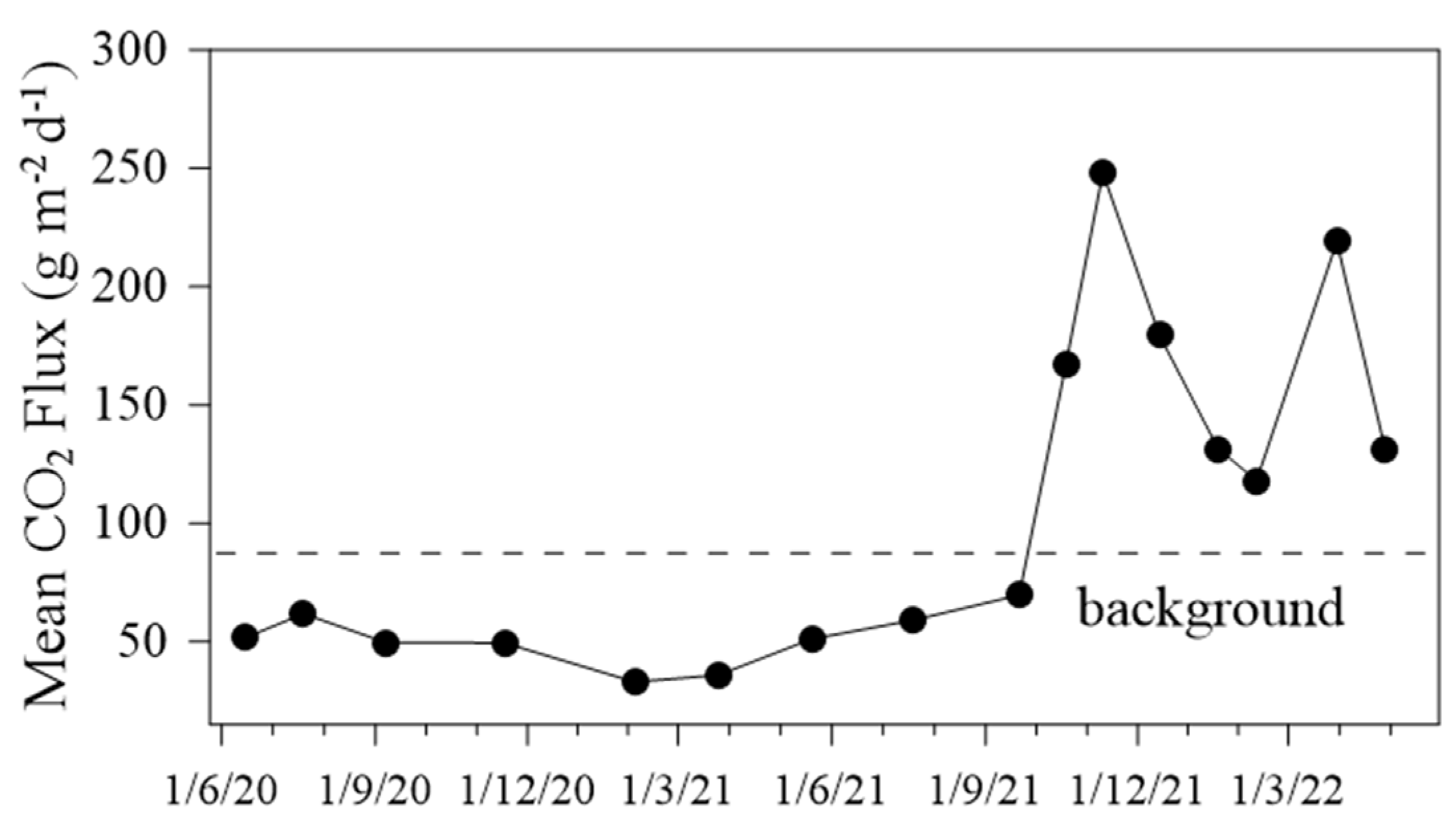
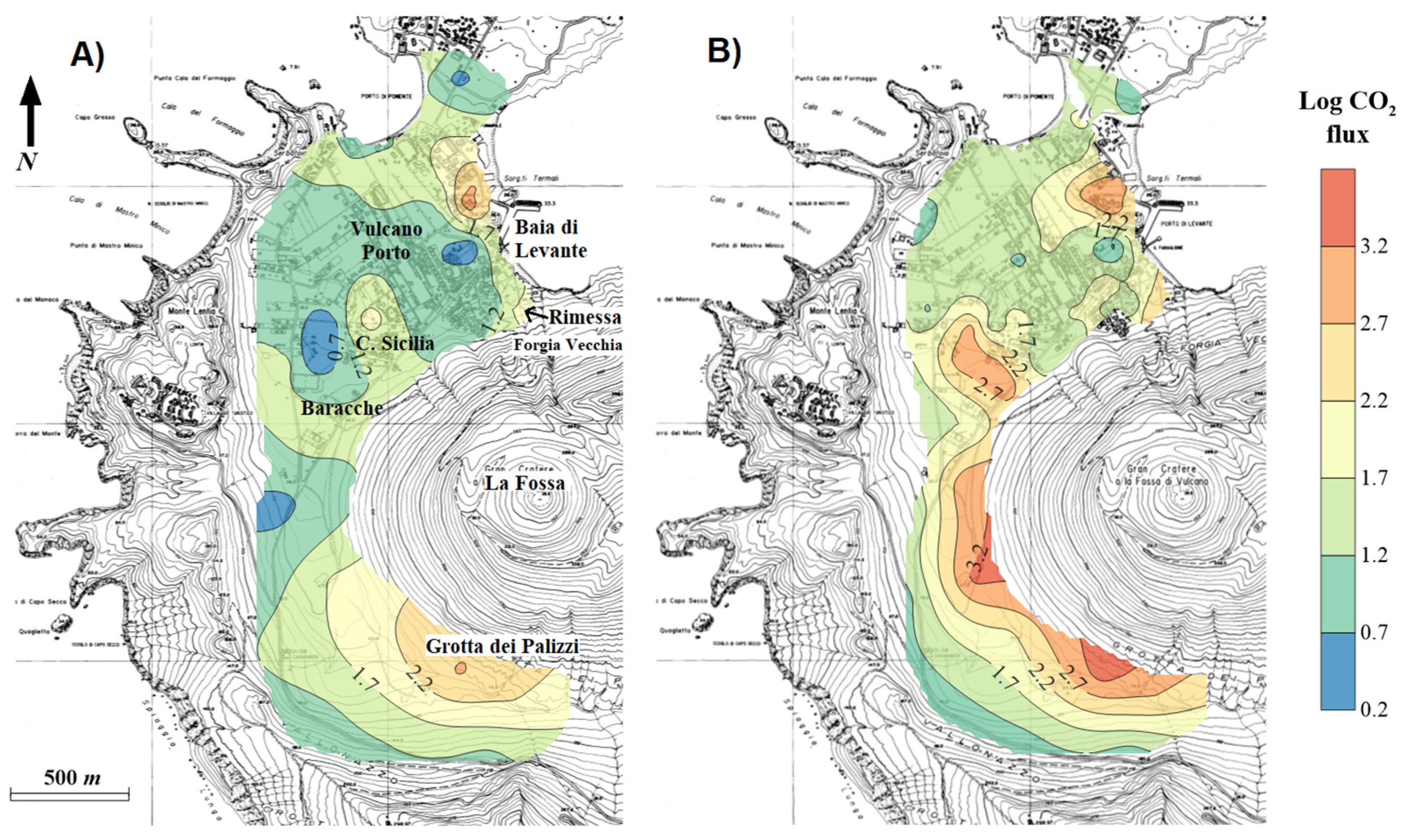
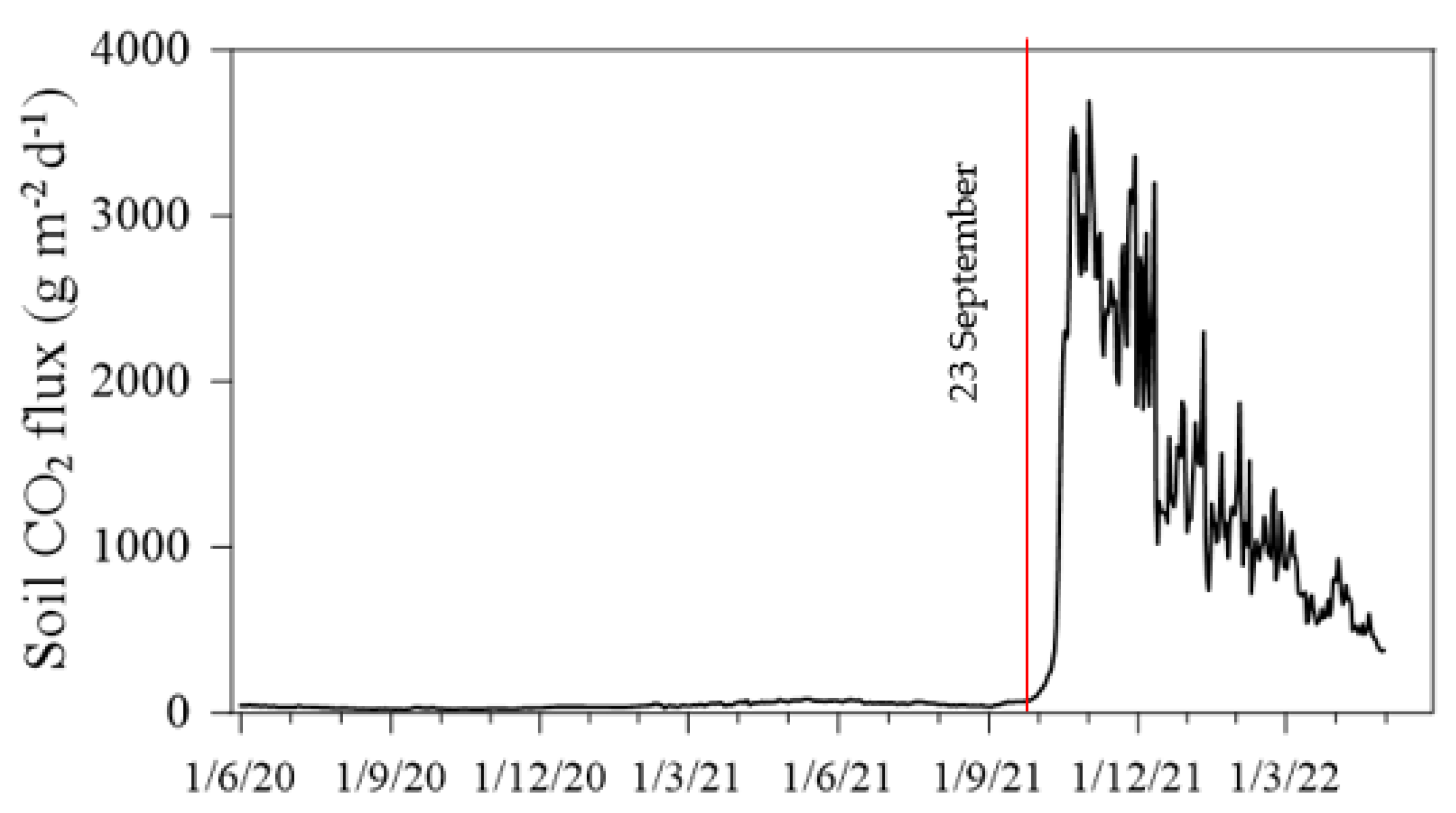
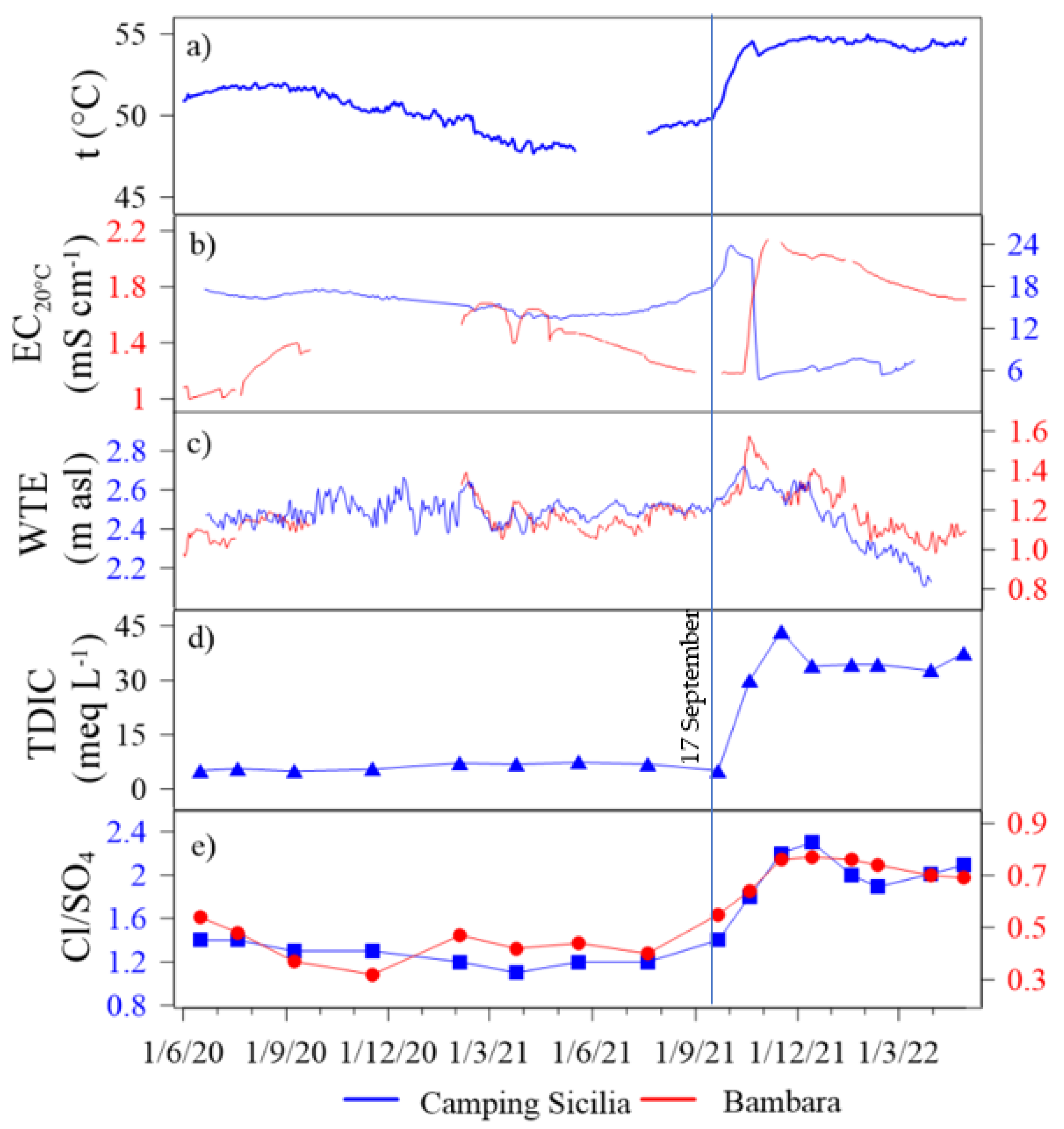

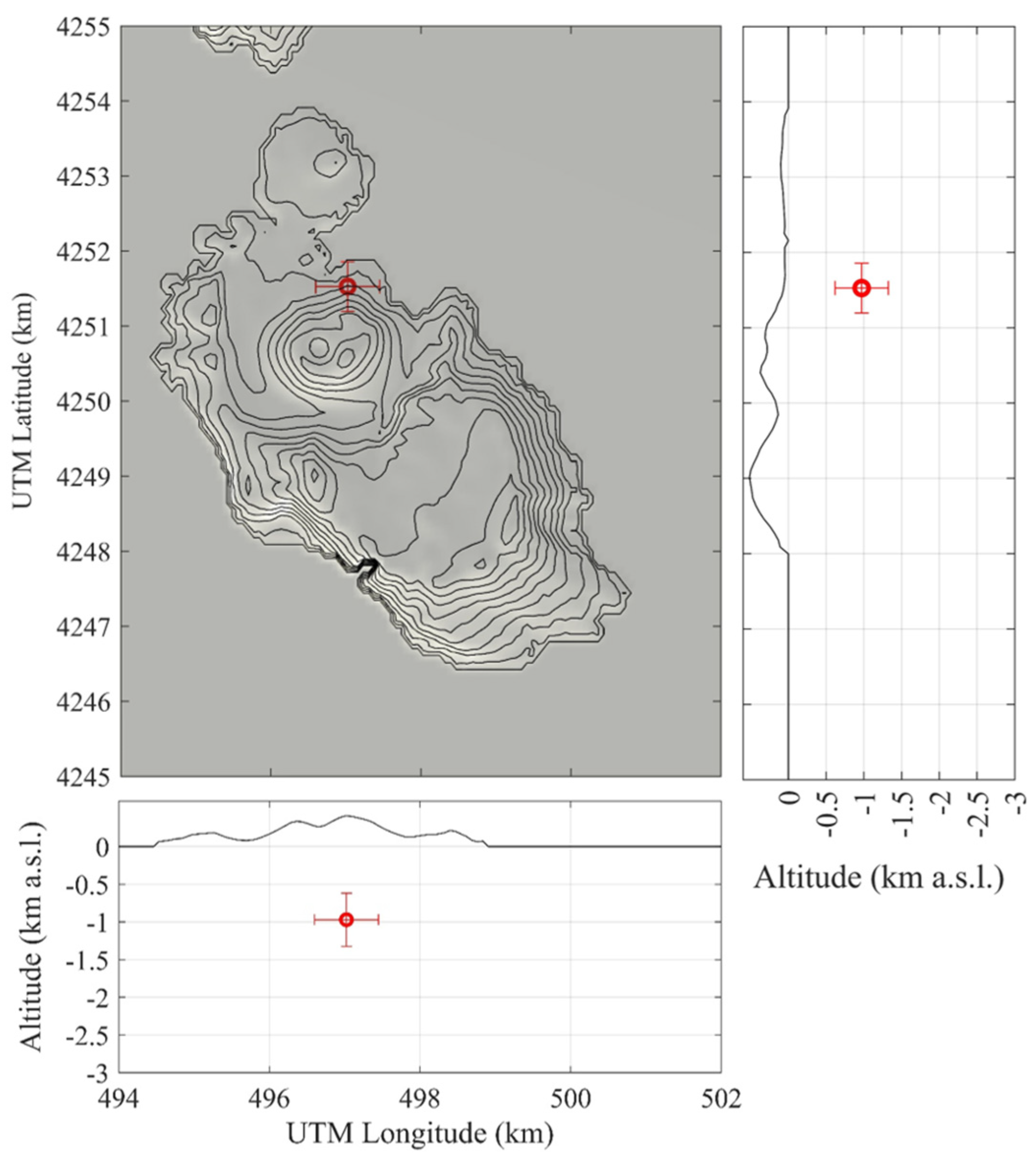
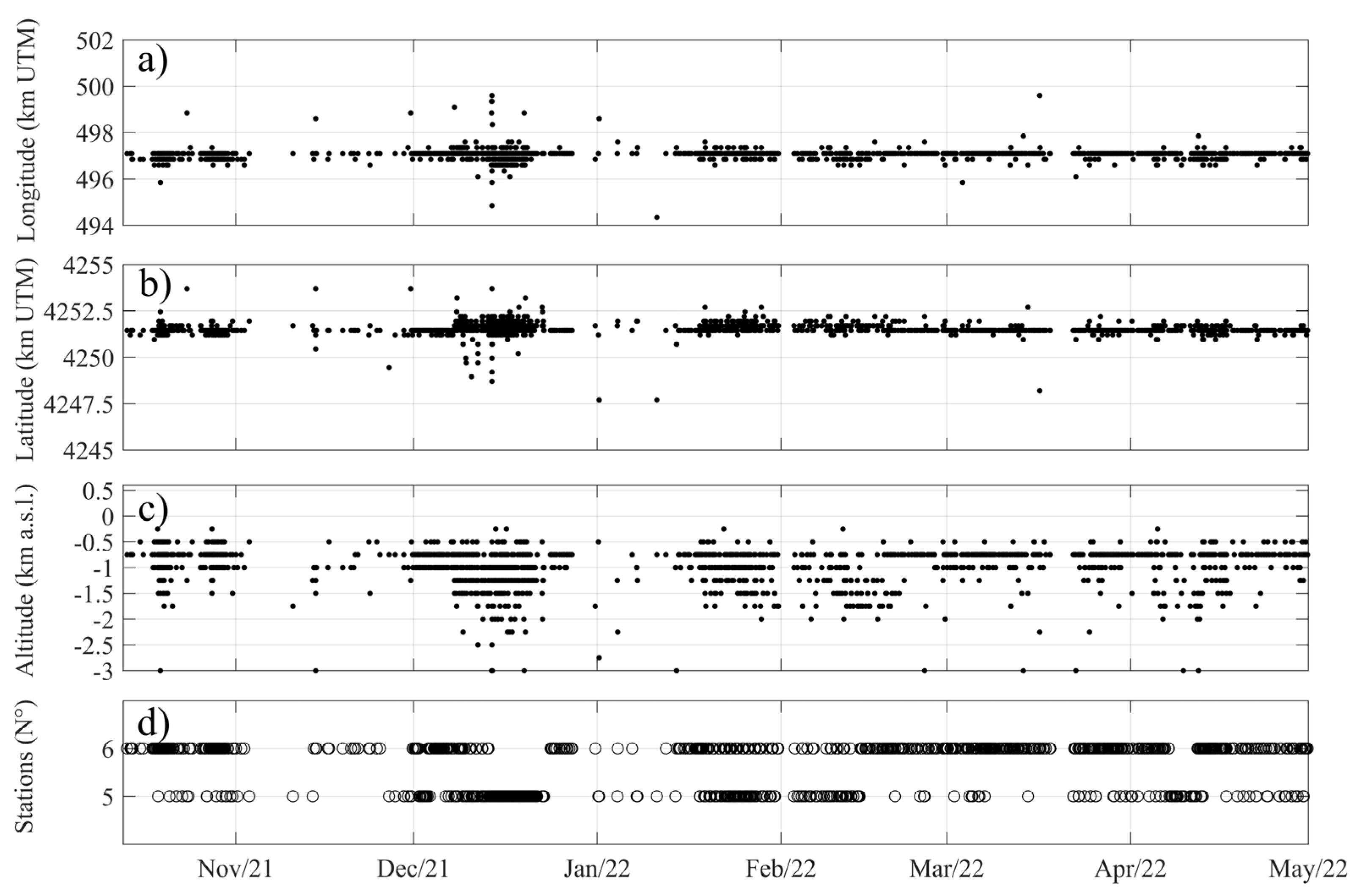
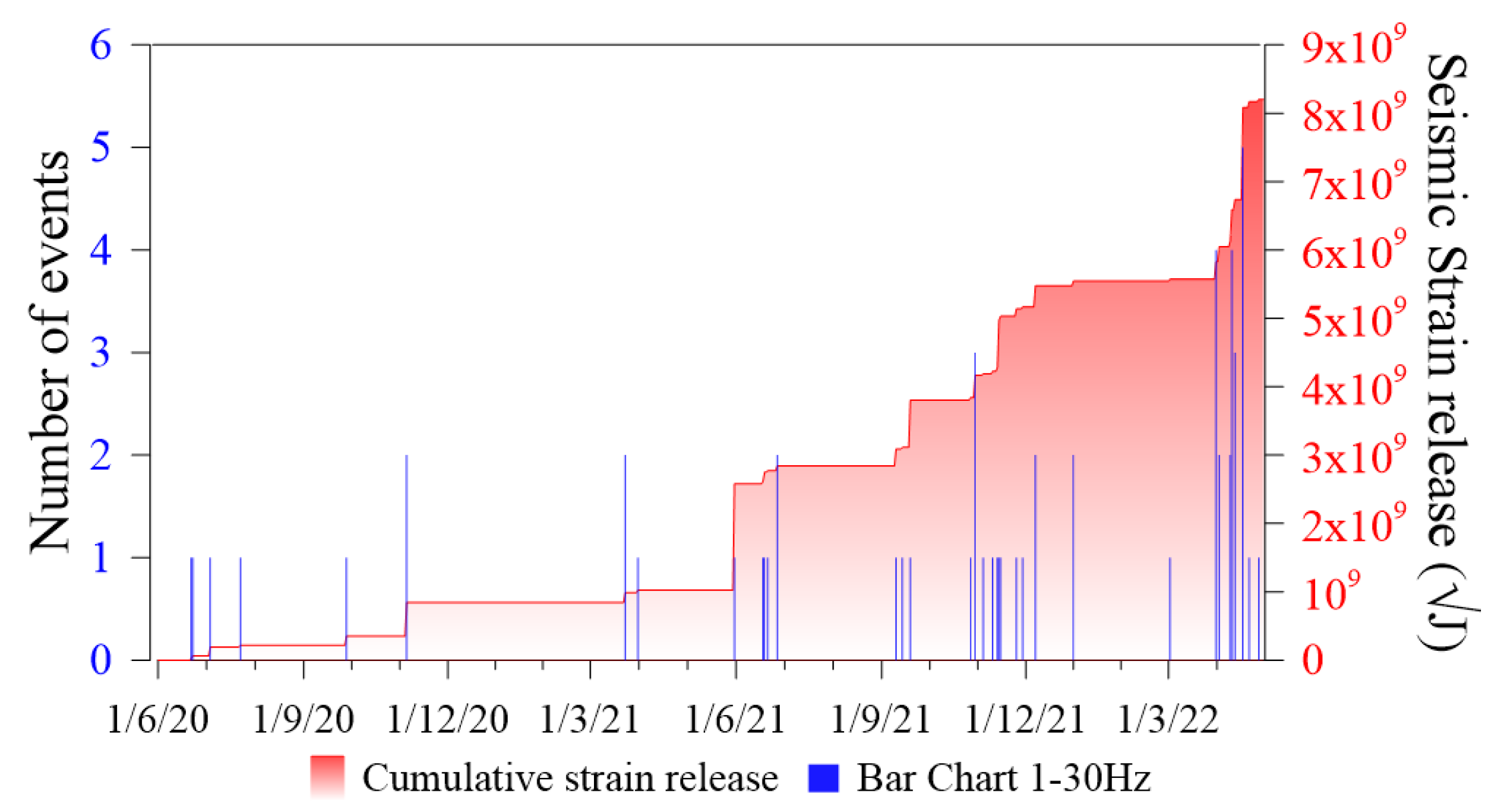
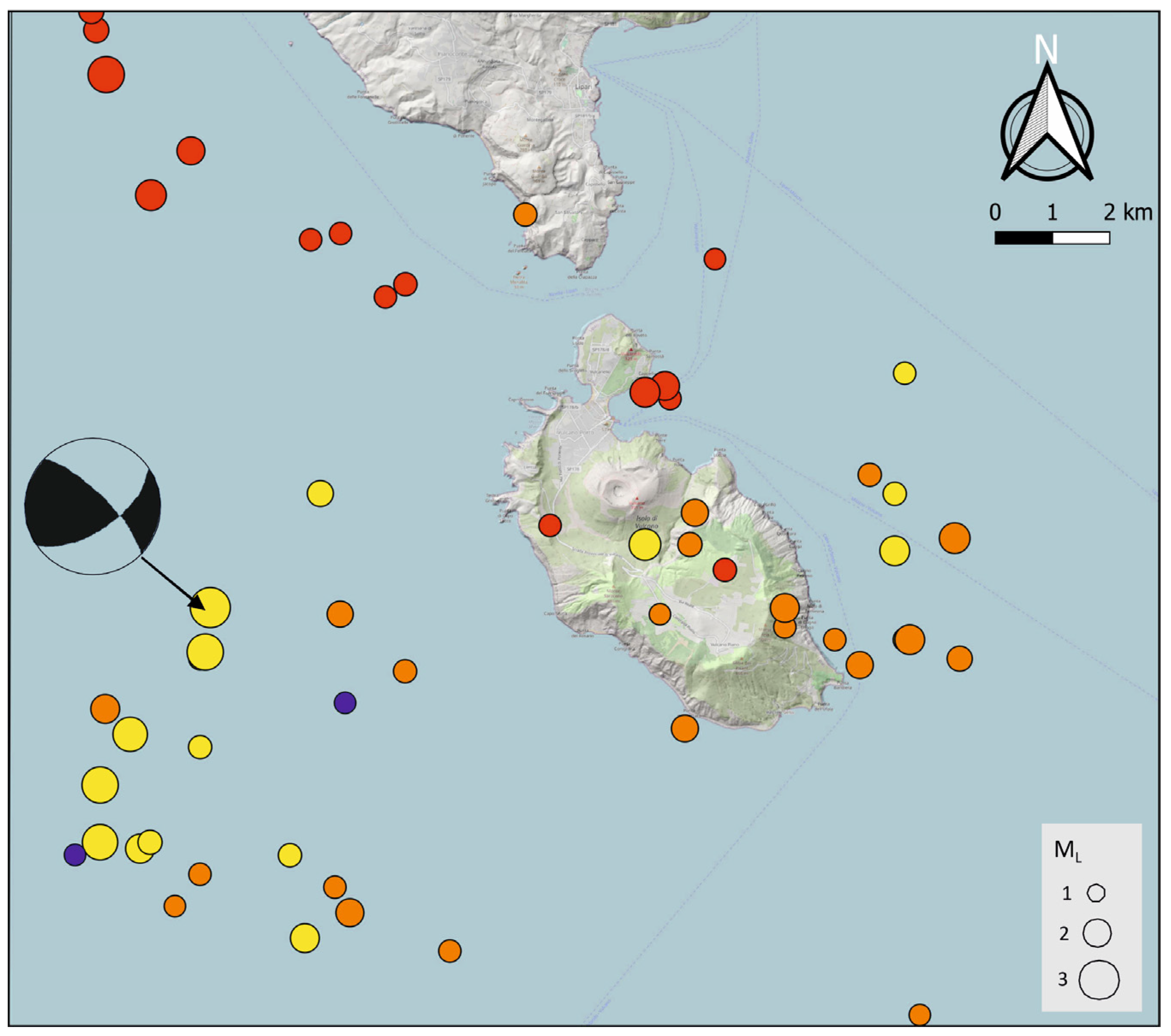

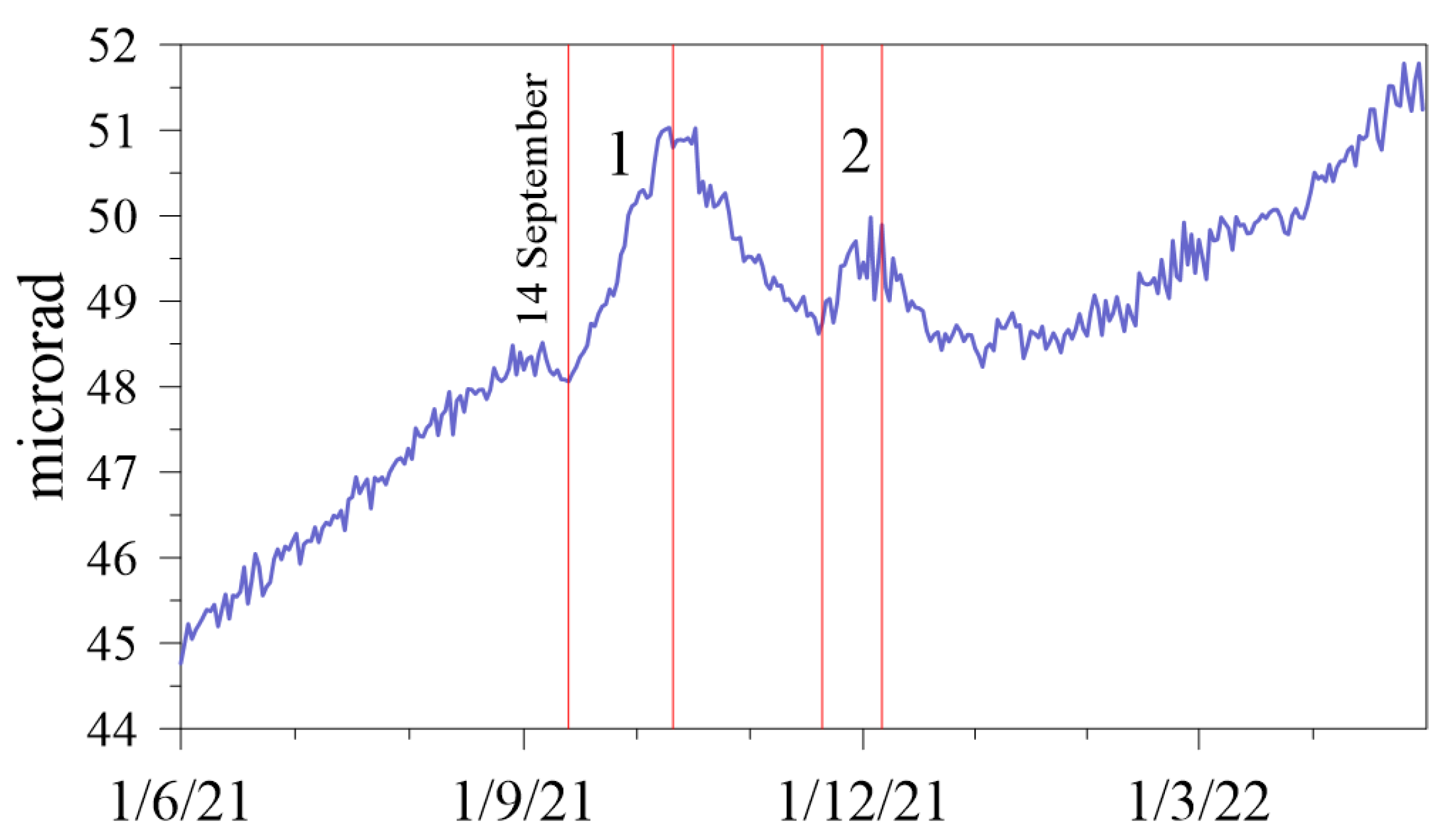
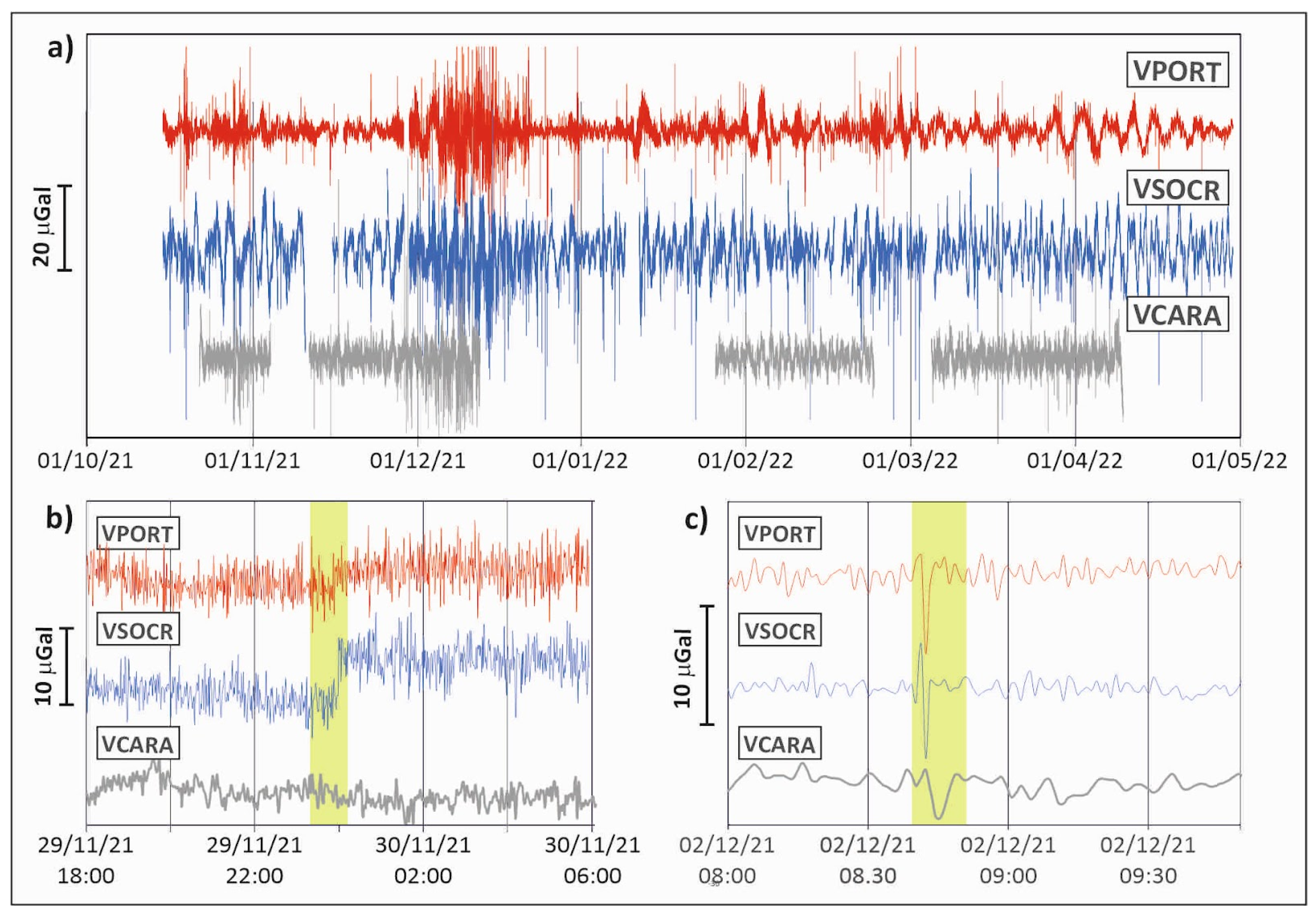
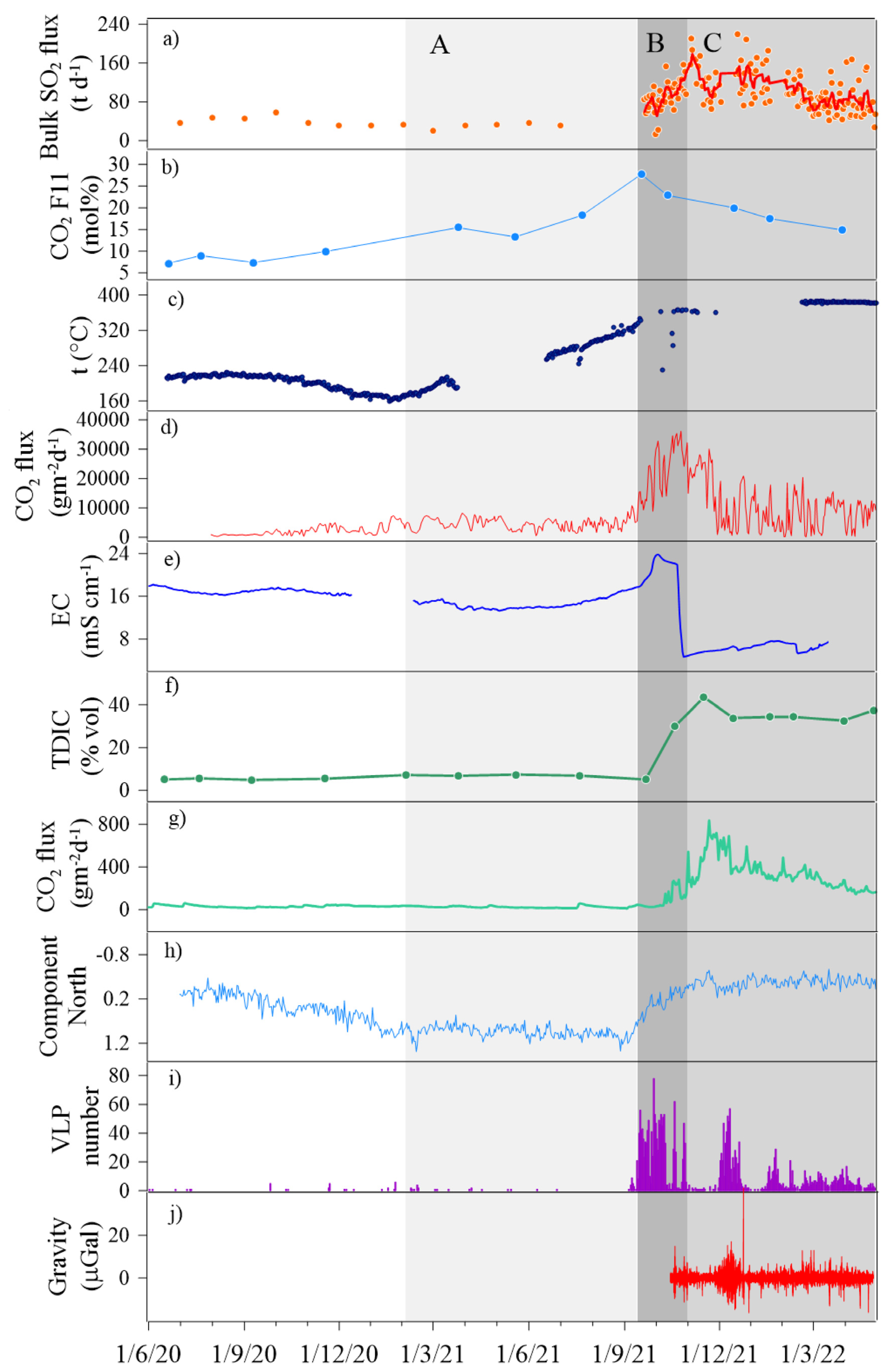
Disclaimer/Publisher’s Note: The statements, opinions and data contained in all publications are solely those of the individual author(s) and contributor(s) and not of MDPI and/or the editor(s). MDPI and/or the editor(s) disclaim responsibility for any injury to people or property resulting from any ideas, methods, instructions or products referred to in the content. |
© 2023 by the authors. Licensee MDPI, Basel, Switzerland. This article is an open access article distributed under the terms and conditions of the Creative Commons Attribution (CC BY) license (https://creativecommons.org/licenses/by/4.0/).
Share and Cite
Federico, C.; Cocina, O.; Gambino, S.; Paonita, A.; Branca, S.; Coltelli, M.; Italiano, F.; Bruno, V.; Caltabiano, T.; Camarda, M.; et al. Inferences on the 2021 Ongoing Volcanic Unrest at Vulcano Island (Italy) through a Comprehensive Multidisciplinary Surveillance Network. Remote Sens. 2023, 15, 1405. https://doi.org/10.3390/rs15051405
Federico C, Cocina O, Gambino S, Paonita A, Branca S, Coltelli M, Italiano F, Bruno V, Caltabiano T, Camarda M, et al. Inferences on the 2021 Ongoing Volcanic Unrest at Vulcano Island (Italy) through a Comprehensive Multidisciplinary Surveillance Network. Remote Sensing. 2023; 15(5):1405. https://doi.org/10.3390/rs15051405
Chicago/Turabian StyleFederico, Cinzia, Ornella Cocina, Salvatore Gambino, Antonio Paonita, Stefano Branca, Mauro Coltelli, Francesco Italiano, Valentina Bruno, Tommaso Caltabiano, Marco Camarda, and et al. 2023. "Inferences on the 2021 Ongoing Volcanic Unrest at Vulcano Island (Italy) through a Comprehensive Multidisciplinary Surveillance Network" Remote Sensing 15, no. 5: 1405. https://doi.org/10.3390/rs15051405
APA StyleFederico, C., Cocina, O., Gambino, S., Paonita, A., Branca, S., Coltelli, M., Italiano, F., Bruno, V., Caltabiano, T., Camarda, M., Capasso, G., De Gregorio, S., Diliberto, I. S., Di Martino, R. M. R., Falsaperla, S., Greco, F., Pecoraino, G., Salerno, G., Sciotto, M., ... Sortino, F. (2023). Inferences on the 2021 Ongoing Volcanic Unrest at Vulcano Island (Italy) through a Comprehensive Multidisciplinary Surveillance Network. Remote Sensing, 15(5), 1405. https://doi.org/10.3390/rs15051405















